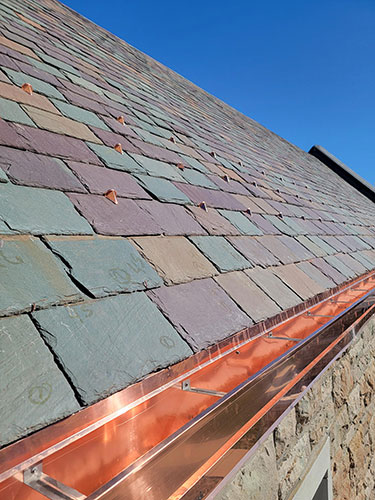
| Contact Us for Consultation |
Our Services New Tile & Slate Installation |
| Servicing KC Metro Including: Johnson County, KS Fairway, KS Leawood, KS Mission Hills, KS Overland Park, KS Shawnee, KS |
| Kansas City Metro Gladstone, MO Grandview, MO Kansas City, KS Kansas City, MO Lee's Summit, MO Liberty, MO North Kansas City, MO Parkville, MO |
Ice Dams Information
Ice dams form when heat from the house escapes into the attic or any area between the heated interior and the roof deck and warms the roof enough to melt snow on top or sides. Because hot air rises, higher areas on the roof tend to be warmer than lower areas. Snow in contact with roofs surfaces with temperatures above 32 degrees Fahrenheit will melt. When the snowmelt flows downslope to a colder part of the roof ‐ typically the eaves, but not always ‐ it refreezes. As this freeze thaw cycle recurs, a ridge of ice develops and traps water on the roof. That water frequently leaks into the home, damaging walls, floors, ceiling and insulation.
Conditions that usually contribute to ice dams begin with moderate to heavy snow followed by daytime temperatures of 15 to 25 degrees Fahrenheit. When it gets much colder than that, the average modern home has enough insulation to prevent the roof deck from warming to the point where snow melts. On the other hand, when temperatures reach into the 30s, the snow on the roof can melt away too quickly for it to refreeze, but in many cases it does refreeze overnight and the ice dams remain.
Myths about Ice Dams
Ice dams happen only on older homes
Ice dams are often associated with older homes but newer homes can be affected because of poor ventilation and in-proper air sealing.
Ice dams are related to gutters
Gutters do not cause or even increase the severity of ice dams. Ice dams are removed from homes that don't even have gutters, but because of the weight of the ice, they can be very damaging to gutters.
Ice dams happen only at the eaves
Most ice dams do form at the eaves, but they do show up in other areas. They can show up in valleys, shed dormers, roof pans and other low pitched areas. There can be mini ice dams around all types of roof penetrations, including skylights, bath fans, chimneys and plumbing vents.
Self-adhering membranes will prevent leaks
Self-adhering membranes reduce the severity of leaks, they do not prevent them. Ice is strong enough to work its way under the membrane and cause a leak.
Heat cables are the answer
Heat cables normally last only a few years and use a lot of electricity and if you use them, there needs to be an area where the water can drain to the ground. Heat cables can dry out asphalt shingles causing them to dry out and voiding the manufacturer's warranty.
Steps that can be taken to minimize ice dams
Air sealing is perhaps the most crucial step in preventing ice dams. In the attic, look for gaps around vents, chimneys, recessed lights, plumbing and wiring penetrations and attic hatches. Top plates at partition wall are another source of leaks, pull back the insulation at these spots and seal them one at a time. In older homes, pull off all the old insulation and seal them and install new insulation. Proper ventilation and insulation is necessary to prevent ice dams, but in many cases, poor house design is the main cause of the problem.
Please call (816) 935-2066 or visit our contact us page to find out how Integrity Solutions can help.

| Phone: (816) 935-2066 | 11810 S. Cave Rd, Lone Jack, MO 64070 | © 2025 Integrity Solutions, LLC |